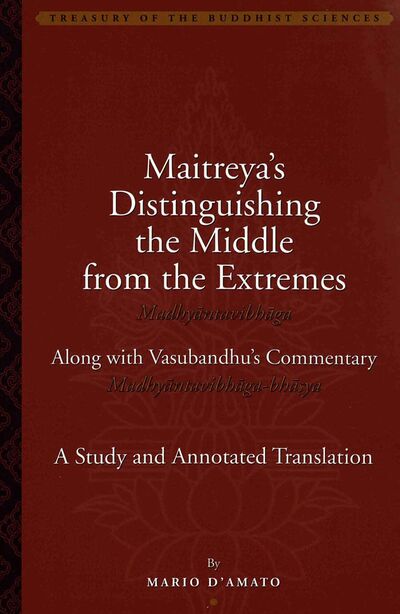No edit summary |
No edit summary |
||
| Line 9: | Line 9: | ||
|FullTextRead=No | |FullTextRead=No | ||
|TextTranslated=Texts/Madhyāntavibhāga | |TextTranslated=Texts/Madhyāntavibhāga | ||
|BookToc=Series Editor’s Preface | |BookToc=* {{i|Series Editor’s Preface|xi}} | ||
Author’s Preface | * {{i|Author’s Preface|xv}} | ||
Abbreviations | * {{i|Abbreviations|xix}} | ||
Part One: Introduction | |||
Study of the Madhyāntavibhāga | * {{i|Study of the Madhyāntavibhāga|3}} | ||
Yogācāra Buddhist Philosophy | ** {{i|Yogācāra Buddhist Philosophy|3}} | ||
What Is Yogācāra | *** {{i|What Is Yogācāra|5}} | ||
Ālaya-vijñāna | *** {{i|Ālaya-vijñāna|9}} | ||
Vijñapti-mātra | *** {{i|Vijñapti-mātra|12}} | ||
Trisvabhāva | *** {{i|Trisvabhāva|15}} | ||
A Semiotic Soteriology | *** {{i|A Semiotic Soteriology|20}} | ||
The Madhyāntavibhāga Corpus | ** {{i|The Madhyāntavibhāga Corpus|28}} | ||
Madhyāntavibhāga | *** {{i|Madhyāntavibhāga|29}} | ||
Madhyāntavibhāga-bhāsya | *** {{i|Madhyāntavibhāga-bhāsya|32}} | ||
Madhyāntavibhāga-tīkā | *** {{i|Madhyāntavibhāga-tīkā|34}} | ||
Authorship and Dates | *** {{i|Authorship and Dates|36}} | ||
The MAV/Bh’s Relation to Other Texts | *** {{i|The MAV/Bh’s Relation to Other Texts|41}} | ||
The MAV/Bh’s Place in the Yogācāra Tradition | *** {{i|The MAV/Bh’s Place in the Yogācāra Tradition|45}} | ||
The Exegesis of the | ** {{i|The Exegesis of the Madhyāntavibhāga|48}} | ||
Exegesis of the Introduction | *** {{i|Exegesis of the Introduction| 48}} | ||
Exegesis of Chapter 1: Definitions | *** {{i|Exegesis of Chapter 1: Definitions|50}} | ||
Exegesis of Chapter 2: Obstructions | *** {{i|Exegesis of Chapter 2: Obstructions|66}} | ||
Exegesis of Chapter 3: Reality | *** {{i|Exegesis of Chapter 3: Reality|74}} | ||
Exegesis of Chapter 4: Cultivation of Antidotes, States, | *** {{i|Exegesis of Chapter 4: Cultivation of Antidotes, States, and Results|87}} | ||
and Results | *** {{i|Exegesis of Chapter 5: The Unsurpassed Vehicle|95}} | ||
Exegesis of Chapter 5: The Unsurpassed Vehicle | *** {{i|Exegesis of the Concluding Verse|110}} | ||
Exegesis of the Concluding Verse | Part Two: Annotated Translation of the Madhyāntavibhāga/-bhāsya | ||
Part Two: Annotated Translation of the | ** {{i|Introduction| 115}} | ||
Introduction | ** {{i|I. Definitions|117}} | ||
I. Definitions | ** {{i|II. Obstructions|131}} | ||
II. Obstructions | ** {{i|III. Reality|143}} | ||
III. Reality | ** {{i|IV. Cultivation of Antidotes, States, and Results|161}} | ||
IV. Cultivation of Antidotes, States, and Results | ** {{i|V. The Unsurpassed Vehicle|173}} | ||
V | ** {{i|Concluding Verse|192}} | ||
Concluding Verse | |||
Glossary, Bibliography, and Index | Glossary, Bibliography, and Index | ||
Glossary | * {{i|Glossary|195}} | ||
Bibliography | * {{i|Bibliography|199}} | ||
Index | * {{i|Index|213}} | ||
|AddRelatedTab=No | |AddRelatedTab=No | ||
|StopPersonRedirects=No | |StopPersonRedirects=No | ||
}} | }} | ||
Revision as of 15:00, 21 August 2020
Maitreyanātha's Distinguishing the Middle from the Extremes (Madhyāntavibhāga) was transmitted to us by the noble Asaṅga, great saint and champion scholar of fourth century CE Indic Buddhism—along with Vasubandhu’s commentary on the text. It is one of the five seminal texts of what the Tibetans call the “magnificent deeds tradition of universal vehicle Buddhism, according to its spiritual focus and ethical impact. Its emphasis on the nondual, primarily mental nature of reality most powerfully supports the great messianic vow of the bodhisattva, the entry into the universal vehicle lifestyle. In his study introducing the translation, Dr. D'Amato analyzes and elucidates the teachings of this text and its associated school with great learning and insight. (Source: Tibet House)
| Citation | D'Amato, Mario, trans. Maitreya's Distinguishing the Middle from the Extremes (Madhyāntavibhāga): Along with Vasubandhu's Commentary (Madhyāntavibhāga-bhāṣya); A Study and Annotated Translation. Treasury of the Buddhist Sciences. Tengyur Translation Initiative. New York: American Institute of Buddhist Studies, Columbia University's Center for Buddhist Studies and Tibet House US, 2012. |
|---|---|


